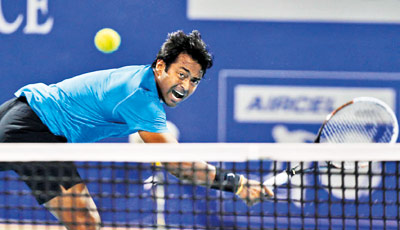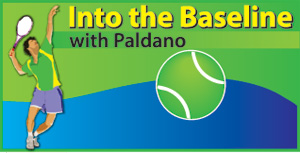‘Evergreens’ surf through

Leander Paes in action
The last eight of the Melbourne doubles and mixed doubles had names such as Martina Hingis, Sanya Mirza, Leander Paes, Stepanek, Bryan brothers, Williams sisters and others known in singles, participating in numbers. They are Tennis ‘ever-greens’.
The Czech Republic had the most number of players in overall quarter-finals. Germany, China, Brazil, India, Uruguay, Canada and surprisingly England had their share of prominence in doubles.
The game of doubles is no more a side show. In the Australian-Open this year the most successful doubles player was Bruno Soares of Brazil. Bruno won the mixed doubles with Vesnina of Russia and then went on to win the men’s doubles with Jamie Murray, the brother of Andy Murray.
Small but sure money
The present demands in the professional circuit burns most of the singles players out after five to eight years. Exceptions are Federer, Djokovic, Williams and a few others.
When this happens to sportsmen their lack of maturity does not allow them to develop into financial wizards with the little money they collect.
In the past many good world beaters have taken early retirement to gamble in the financial sectors and have ended up in bad straits.
In this context doubles is a ‘god sent’ to top up the earnings players collect from singles. The good distribution of prize money from the very first round are keeping many in singles even into their late thirties and doubles is keeping players in the tour even in their forties.
The switch from singles to doubles is easy only if the player has been a good all-court player. Front court play dominates doubles more than in singles. If a player has command over all-court-strokes, then they are successful in doubles.
In doubles, the effective tactical game plan involves covering and using the ‘breadth’ of the court tactically more than the length of the court. Other aspect of doubles is the speed of rallies as rapids and also as short bursts.

Speed and combination
The Tennis, the expression ‘he or she is fast’ refers to the reaction speed and not the running speed attained over a distance. As players, we use around 48 different movements and combinations of movements to cover the court and to play a ball back effectively. It is the speed of this reaction that is critical in doubles to play effective shots.
The most a player could run on the court at a time is up to eleven strides in less than a second and there will be a time squeezed scramble to play an effective stroke. This would indicate the reaction speed in the modern Tennis game.
The reaction speed of doubles today can reach nearly three shots per second. This speed has been recorded. In this situation an understanding partnership is the key for success. It is the reason why two good singles players do not play the best doubles.
The complementary nature of a player in a partnership is very evident when Sanya Mirza plays with Martina Hingis and also in the Bryan brothers.
It is said that in doubles, it is very good to surprise the opponents but surprising one’s own partner, is tactical suicide. Complementing the partner is the secret of successful in doubles.
Attractive Prize money
The total prize money at the Aussie-open 2016 was US dollars 31 million. The men’s and women’s singles winners took home the ‘lion’s share’ of US dollars 2.73 million and the singles players were offered prize money from the very first round.
Doubles started payment only from the second round at 14,000 Australian dollars and the winners went home with 650,000 Australian dollars. The total was 2.6 million Australian dollars for each of the doubles but the mixed-doubles did not get much.
These are substantial increases in Tennis prize money. The 1967 Wimbledon runner-up got only 33 pound-sterling. I have seen this cheque as it is kept as a souvenir by the winner.
The two professional bodies will conduct over sixty events in each gender in thirty countries. The total prize money for men this year only in the Grand-Slams will exceed US dollars 120 million. Federer tops career prize money with US dollars 97 million while Djokovic is very close behind him.
Incredible Leander Paes
It is easy not to remember the names of the second fifty in the singles world rankings. When players struggle to get above the 30 mark for two or three years in singles, doubles becomes their option.
There is a critical issue here that is finding a compatible partner. The most successful man in doubles when it comes to compatibility in the last two decades is Leander Paes of India.
He has had more men and women players by his side than any other. He is in his forties and appears in quarters, semis, finals and as winner of men’s and mixed-doubles regularly.
His all-court game and very good reflexes along with early sighting, is the ideal development for doubles. We are bound to see more of him in the next few years before he fades away leaving a historic trail like many other Indians. In the meantime ‘ever greens’ are surfing the newly gained doubles popularity, very well.
George Paldano, Former int. player; Accredited Coach of Germany; National, Davis-Cup, Federation Cup coach–. georgepaldano@yahoo.com


